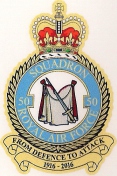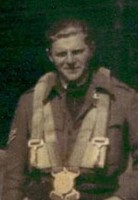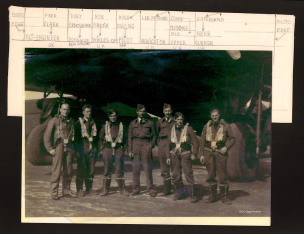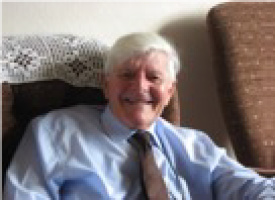Sgt E A McDonald
Alan was born 1922 in Hull. On leaving school at 14 he obtained an apprenticeship at an electrical firm to be an electrician. This apprenticeship was suspended when he joined the Royal Air Force, volunteering for aircrew he was turned down and told he needed some qualifications. He still joined the RAF and after square bashing at Padgate he was posted to Northern Ireland.
1941 On Flying Control before becoming aircrew and was based at Nuts Corner in Northern Ireland.
An aircraft was going to the mainland, and he was told he could get a trip and got a Wellington to RAF Leconfield to go on leave. 5 were on the aircraft. They landed at Langford Lodge USAF base. The Wimpy was cancelled and they continued their journey by Hudson.
During training, his aircraft crash landed and he was soaked in petrol. He flew 28 operations as a rear gunner with 50 Squadron from RAF Skellingthorpe and recalls seeing aircraft exploding in the air, a dinghy deploying by accident and nearly hitting a WAAF, and making an emergency landing at Juvincourt after being attacked by a FW-190 and being hit by anti-aircraft fire.
TRAINING
10 March1944 No.8 Air Gunnery School RAF Evanton
19 May 1944 14 OTU Market Harborough
24 August 1944 1661 HCU Winthorpe (crewed up)
11 October 1944 No5 LFS Syerston
25 October 1944 50 Squadron, RAF Skellingthorpe
Crew were:
F/O. Hugh Skilling Pilot
Sgt. Fred Clarke Flt/Eng
F/O. Len Retford Navigator
F. Sgt Doug Cruickshank Bomb Aimer
Sgt. Bob Martin Wireless Operator
Sgt. John Meadows Mid Upper Gunner
Sgt. Alan McDonald Rear Gunner
OPERATIONS Green – Daylight op Red – Night Op
- 1/11/1944 Lanc 1 NF984 G Homburg.
- 2-3/11/1944 Lanc 1 NF984 G Dusseldorf
- 4-5/11/1944 Lanc 1 NF984 G Dortmund Ems Canal, Ladbergen.
- 22-23/11/1944 Lanc 1 PB755 Y Trondheim
- 26-27/11/1944 Lanc 1 NF984 G Munich
- 18-19/12/1944 Lanc 1 NF918 F Munich
- 18-19/12/1944 Lanc 1 NF918 F Gydnia
- 1-2/1/1945 Lanc 1 NG984 G Mitteland Canal (Landed in France)
- 13-14/1/1945 Lanc 1 SW262 G Politz
- 14-15/1/1945 Lanc 1 SW262 G Meresburg
- 16-17/1/1945 Lanc 1 SW249 Brux
- 1-2/2 1945 Lanc 1 NG171 Seigen
- 2-3/2/1945 Lanc 1 SW262 G Karlsruhe
- 19-20/2/1945 Lanc 1 LL741 X Bohlen
- 20-21/2/1945 Lanc 1 SW262 G Mitteland Canal
- 24/2/1945 Lanc 1 SW262 G Dortmund Ems Canal Ladbergen
- 3-4/3/1945 Lanc 1 PA222 K Dortmund Ems Canal Ladbergen
- 5-6/3/1945 Lanc 1 SW262 G Bohlen
- 7-8/3/1945 Lanc 1 SW262 G Harburg
- 11/3/1945 Lanc 1 SW262 G Essen
- 12/3/1945 Lanc 1 SW262G Dortmund
- 14-15/3/1945 Lanc 1 SW262 G Lutzendorf
- 16-17/3/1945 Lanc 1 SW262 G Wurzurg
- 23/3/1945 Lanc 1 SW262 G Flensburg
- 4/4/1945 Lanc 1 SW262 G Nordhausen
- 7-8/4/1945 Lanc 1 SW264 F Moblis
- 8-9/4/1945 Lanc 1 SW262 G Lutzendorf
- 25-26/4/1945 Lanc 1 SW262 G Vallo (Crash landed at Raf Woodbridge)
Wing Cmdr Flint said bring it back
Crews often flew in awful weather conditions and flying over mountainous areas in the depths of winter meant that low temperatures sometimes played havoc with electrical and mechanical systems on a
Lancaster.
Mac recalls a raid where having lined up the target, Dougie Cruickshank, the bomb aimer, pressed the bomb release button only to find that nothing had dropped. The release mechanism must have frozen.
Hugh Skilling went round again and this time a few of the smaller bombs fell from the bomb bay. Hugh went around yet again and this time the rest of the small bombs fell leaving the 4,000 lb cookie
stubbornly stuck in its rack. At the earlier briefing, Wing Commander Flint, the CO, had instructed that unused cookies were to be brought back to base as they were in short supply.
They didn’t have enough fuel to go round again and in any event the low temperatures were affecting engine performance. To get home, Hugh Skilling knew that they would have to jettison the cookie
otherwise they wouldn’t have enough fuel to get home. This of course was at variance with the CO’s orders so Hugh asked the other crew members what they thought. All agreed that the cookie couldn’t
be taken home and that the sooner it was dropped the better. They had a target in mind however, a military installation on a mountainside they had spotted on the way over. They
managed to find it, and the cookie was dropped, successfully destroying the target.
However, there was a loud noise and the aircraft shook as the bomb exploded, almost as if they had been hit or some damage had been done when the cookie left the aircraft. Hugh asked Bob Martin to go
through the fuselage to check for damage but fortunately there was none. What had happened was that dropping the cookie on a mountainside meant that they hadn’t allowed for the height of the mountain
to achieve a safe height from the blast. Apparently cookies should be dropped at not less than 10,000 feet. They had a narrow escape. Had they been lower, the aircraft could have been seriously
damaged or even destroyed.
The flight home was uneventful, but the fuel situation was looking dire and there was a possibility that the crew might need bale out before they reached the Wash. The engines were still playing up
due to the low temperatures but they did make it, landing at Tangmere, a fighter station, with almost completely empty fuel tanks.
So much for a quiet New Years Day.
New years day 1945 at Skellingthorpe was supposed to be a quiet, relaxing day. No operations were planned and crews were enjoying the rest.
However all this came to an end when the tannoy crackled into life telling 9 crews to report to the briefing room immediately. The Skilling crew was one of them. An urgent attack was needed on the
Mittelland canal at Gravenhorst, a target that had been bombed several times before. The urgency was because tiger tanks were being transported on barges and it was imperative that they were stopped
from reaching the front line. Wireless operator Bob Martin didn’t go on this raid, I don’t know why, and his place was taken by F/S J Booth, who was Wing Commander Flint’s wireless op.
The 50 squadron lancasters joined aircraft from several other squadrons to make up a force of 152 lancasters and 5 Mosquitos. The weather was very poor and at least 2 aircraft crashed during or
shortly after takeoff. Whilst en route to the target, rear gunner Alan Macdonald saw two lancasters explode and when, what he believed to be a rocket, skimmed the top of VN-G filling his turret with
smoke, he realised that they had been attacked head on by a focke wolf 190 night fighter. He then saw the german aircraft but was unable to open fire for fear of hitting a nearby lancaster. The raid
was a success despite heavy cloud cover, the canal being badly damaged with over half a mile of
banking being pitted with bomb craters.
On turning for home, the aircraft picked up a Gee radio navigation signal so they set course to follow the signal which in theory should have led them home. However, what they didn't know was that
this was a false signal transmitted by the Germans and that it was leading them towards Frankfurt and into some of the heaviest defences in the Reich. However, they realised that something was wrong
and having checked their heading knew that they had been fooled. They changed course and were approaching Liege when they came under anti aircraft fire. When they were over Liege, they were hit by
the blast from a shell exploding nearby. (Mac believes that this was shellfire from American anti aircraft guns using proximity fused shells- (Liege having been liberated by the american first army
the previous September). The blast tore away a section of the nose of the aircraft on the starboard side from the front turret to the flight engineers position.
Luckily, Fred Clark the flight engineer wasn’t sat at his position at that time otherwise he would probably have been killed.
With the hydraulics damaged,the Lancaster almost immediately became uncontrollable despite Hugh Skilling’s efforts to maintain level flight. VN-G quickly slipped into a dive so Hugh ordered the rest
of the crew to prepare to bale out although both Mac and the navigator didn’t hear because the intercom had been damaged. The other crew members took up their positions at the rear fuselage door and
Dougie Cruickshank, the bomb aimer, took up his position by the hatch underneath the nose. As the dive became steeper, Hugh Skilling suddenly found that he had regained some control over the aircraft
and was able to slowly pull out of the dive. He told the crew not to bale out and to return to their positions. Mac of course hadn’t heard any of this and Dougie Cruikshank, who
at first said he had not heard the command, baled out. (In later life he did admit that he had heard the command but nevertheless decided to bail out).
The Lancaster was proving difficult to handle and the port engines had to be feathered due to rising temperature and falling oil pressure.The wireless operator received a diversion message and when
he later received light QDM’s on Juvencourt they set a course for that airfield which had been recently captured by American troops. There was no time to circle and wait their turn to land so they
came straight in and landed heavily. The brakes were not working properly and the Lancaster careered off the end of the runway and came to rest in a field. Fortunately, no one was hurt although VN-G
was a write off. It was used for spares and the rear turret was fitted to a damaged Lancaster that landed shortly afterwards. The crew reported in and when Mac took his
parachute to the stores he met up with the airman he met previously who had wanted 7s 6d to repack the parachute. The crew were invited to the mess and were treated to American rations.
They were offered a full roast meal with turkey but having had enough of vegetables they opted for turkey only. Before turning in, Mac and Johnnie Meadows, the mid upper gunner, went for a wander
around the airfield which was strewn with German equipment and aircraft. Mac was told off by an officer on more than one occasion when he was caught trying to climb into two aircraft, a Focke-Wulf
190 and a Heinkel 111, which, he was told, might have been booby trapped. They spent the night in barracks that had been a german brothel and Mac was given a bed which he promptly fell out of.
Apparently it pivoted in the middle, no-one is sure why, so Mac had to put something underneath to stop it moving.
During the stay at Juvencourt, Mac looked around the damaged Lancaster and found the piece of shrapnel he is sure had jammed the controls almost causing a fatal crash. Mac believes that the metal was
dislodged when the aircraft went into a violent dive thus freeing the control cables. He threw it away into nearby bushes. He also found that a piece of shrapnel had pierced the armour plate on the
back of the pilot’s seat. Had Hugh Skilling been leaning back it might have killed him.
The aircraft was a mess inside and Mac also found that shrapnel has also cut off the top of the navigators boot but without touching his leg. A narrow escape!
Whilst 6 crew members were enjoying a quiet stay at Juvencourt, things were a little different for Dougie Cruikshank who had baled out. Dougie landed in a wooded area and having hidden his parachute
he cut the tops off his flying boots to make them look more like shoes. Using his escape compass, he set about trying to make his way west towards the allied lines. He eventually came to a road and
started to walk. He almost froze when he came around a bend in the road and saw two German soldiers with fixed bayonets walking in the same direction. Dougie decided to just casually walk past them
and he got away with it . They just ignored him, there was no challenge, and until
he got out of sight Dougie was in constant fear of a voice suddenly telling him to halt and the sound of a rifle bolt being pulled back.
Eventually, Dougie reached the American lines but instead of a friendly reception, he was marched to the senior American officer who proceeded to interrogate him. The Americans had a lot of
experience of Germans posing as allied personnel and whether it was Dougie’s New Zealand accent that had made them doubt his story no-one knows. Despite his protestations, the American Officer was
convinced that he was German so sentenced him to death by firing squad as a spy.
Dougie was taken outside to join two other prisoners already tied to posts but as the firing squad were preparing to fire, he launched into a tirade of expletives. The Officer halted the proceedings,
saying that he must be who he claimed to be as no German would know that sort of language!!
The crew were eventually reunited and returned to Skellingthorpe safely.
VN-G had been one of 3 damaged Lancasters that landed at Juvencourt that day.






